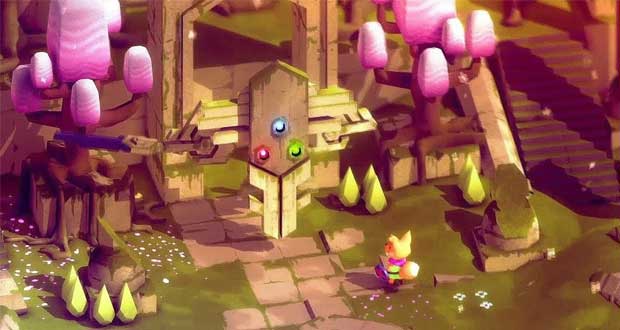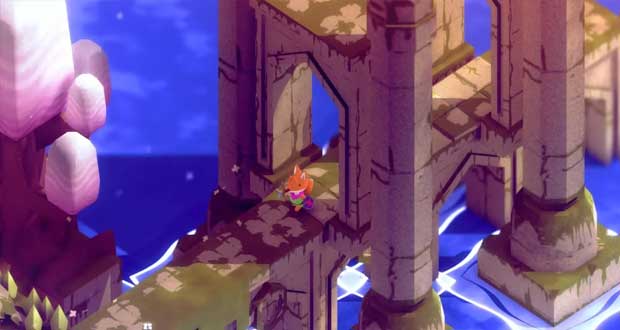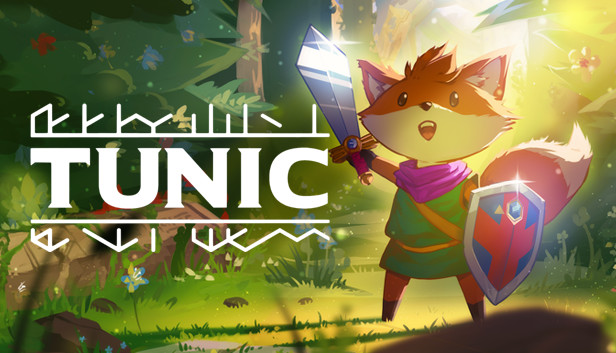Developer: Andrew Shouldice
Publisher: Finji
Our hero – a fox-like creature wearing a distinctive green tunic – washes ashore on a mysterious island. As they explore their surroundings, the hero finds themselves a sword and a shield to fend off hostile creatures. The island contains many secrets. There are strange runes and stone monuments scattered across the land. As the hero travels further inland, he discovers dungeons, temples and pages from an ancient manuscript that begin to unravel the island’s many mysteries.
Tunic is largely the creative vision of a single person – Andrew Shouldice – who left Canadian developer Silverback Productions to develop this impressive debut. The game creates a strong first impression, borrowing heavily from the look and feel of classic top-down Legend of Zelda games from the NES era. The distant isometric camera angle combined with the low-fideilty environmental design gives the game a charming diorama quality. The trees and shrubs that adorn the landscape look like they could be handcrafted and made from origami. There is a warm and inviting feel about the game’s colour palette and cutesy art design that belies the surprisingly sharp difficulty curve in the combat and wilfully oblique puzzles that gate the players progression.
Although at a distance Tunic has all the trappings of a modern day Zelda-like, a few hours of progress in the game reveals many other modern gaming influences. It feels cliche to say at this stage but its impossible not to feel the comparisons to From Software’s Dark Souls games as Tunic‘s combat is mechanically designed around dodge-rolls and carefully timed swipes at enemies where even a basic dungeon creature is capable of defeating you if you get careless or cornered by multiple assailants. Death means getting sent all the way back to your last save point and any acquired experience is lost unless the player can make it back to the location where they were felled. Like I said. Dark Souls.
Where I found Tunic really shines is the puzzle design and exploring the world itself. Tunic was in development for seven years and I have to imagine a good chunk of that time was spent carefully crafting the world and its many dungeons which are filled with enticing secrets for any inquisitive player. This is a game where every time I poked behind a waterfall, looked down a well, explored beneath a bridge or hacked away at shrubs, I would be rewarded with treasure, new weapons or one of the coveted game manual pages – the most triumphant innovation in the game. When Tunic begins, the player is thrown into the action with little to no explanation of what the game mechanics are or what the purpose is of many of the objects that can be discovered. Gradually the player discovered pages from a beautifully illustrated manuscript, which is actually the manual for the game itself, and only then does the game truly reveal itself. There were some supremely satisfying ‘Aha!’ moments that I derived from the pages of the manual, not to mention incredible game-changing mechanics that were hidden in plain sight. The puzzles in Tunic manage to successfully ride the line of being challenging and initially bamboozling but still absolutely solvable without any reliance on dumb luck or a walkthrough guide. The pleasure I felt from unlocking some of Tunic‘s mysteries really felt like they rivalled the best moments of The Witness, Fez and other modern classics of that ilk.
For most players, I would expect the first half of the game to be an absolute thrill. Its retro-inspired visual trappings and satisfying puzzle mechanics will have a broad appeal and will rightly earn the Tunic many plaudits. If you sense there is a ‘…but’ coming, you’d be right. The weakest aspect of Tunic is undoubtedly the combat and in the back half of the game, I think Tunic asks a level of finesse and skill in the player’s ability to bring down some of the late stage bosses that I think many will not be able to match. Some of these boss battles simply feel too difficult and that challenge is accentuated by the somewhat sluggish nature of the controls which feel serviceable when fighting the weaker monsters early on but never quite as sharp as you’d like in the high stakes encounters late in the game.
This late game difficult spike would be a showstopper for me. I think the boss battle in the fourth dungeon is simply beyond me. Where Tunic has a “get-out” clause is in its accessibility options. Its possible to remove the energy meter which is turned on by default and prevents the player from endlessly spamming the dodge roll. About three quarters of the way through the game I turned that off. Then when I hit a wall with one of the bosses, I flicked a switch in the accessibility menu that actually made my character invulnerable. This obviously completely nullified any challenge in the combat sequences for the rest of the game but at that stage I had definitely had my fill of it and was happy I had an opportunity to finish the game and engage with it purely on my own terms as a puzzle/exploration game.
Now, ideally, I would have liked the balance of the combat to have worked in my favour so I wouldn’t need to turn it off entirely. Maybe its just me? I’m not so sure though. Anecdotally, what I read on message boards, heard on podcasts and feedback I got from friends, all suggested the same thing. At a certain point of time it gets too much and you’ll start dialling in some difficulty modifiers to see it through.
Is it enough to spoil the overall experience? Absolutely not. This is still a wonderful game and an easy recommendation. Who knows, perhaps one day a software update may even be able to tweak the late game difficulty and dial it down a notch. Regardless, I found Tunic to be a lot more than I bargained for. It is so much more than the initial impression it forms as a charming but derivative Zelda game. It is easily one of the best action-adventure games of the year.
Review Overview
RATING
GREAT
Summary : A charming, visually-striking and cleverly designed adventure game that is greater than the sum of its parts. A late game difficulty spike is irksome but it is bailed out by its accessibility options.
 The FAT Website est. 1999
The FAT Website est. 1999








j3best
c8jb9y
8mhrk9
vh8060
odzn4w
iths5p